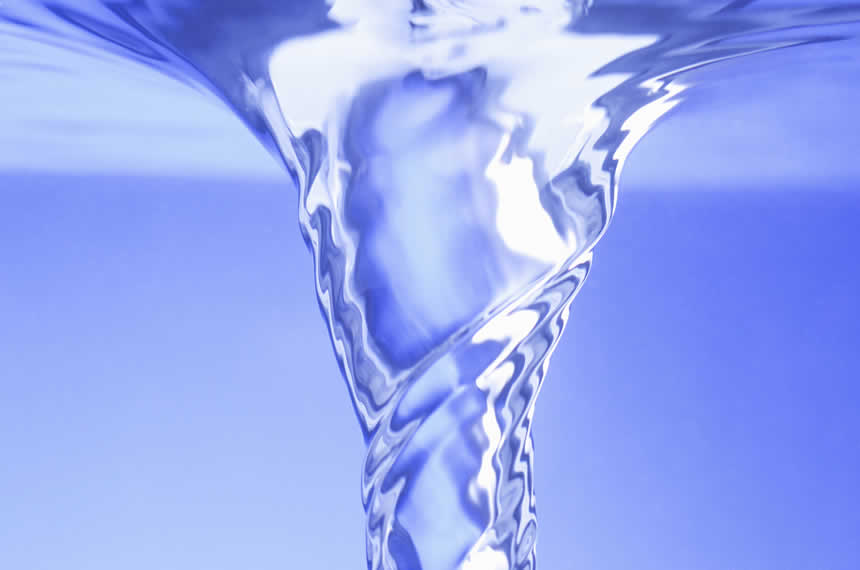Movies and stories at times portray people or boats being sucked into whirlpools – hungry, spinning currents of water – never to be seen again. Are these stories true? If so, what are they?
What are whirlpools?
A whirlpool is a body of swirling water formed when two opposing currents meet. Whirlpools may form wherever water is flowing, from creeks and streams to rivers and seas. Any whirlpool that contains a downdraft – one capable of sucking objects beneath the water’s surface – is called a vortex. Whirlpools also form at the base of waterfalls and man-made structures such as dams.
Most of these phenomena are not very powerful. Even the swirling water formed when the stopper is removed from a sink or bath could properly be called a whirlpool. There are, however, some very powerful and dangerous whirlpools. A maelstrom is defined as a particularly “large, powerful, or violent whirlpool.” Maelstroms typically form in the ocean near narrow straights as a result of the tides.
What’s at the bottom of a whirlpool?
Whirlpools are not, in fact, bottomless pits. Experiments have shown that whirlpools often pull objects to the bottom of the sea bed. They may then be moved along the sea floor by ocean currents. If the object can float, it may come back to the surface a long way from where the whirlpool is located.
Did You Know? Due to the Coriolis effect – the force of the Earth’s rotation – large whirlpools in the Northern Hemisphere tend to spin counter clockwise, while whirlpools in the Southern Hemisphere tend to spin clockwise.
Are Whirlpools Dangerous to People?
Large ships are generally in no danger from whirlpools, although some reports from ancient history say otherwise. It is thought that the mythical Charybdis of the Greeks may have been a whirlpool off the coast of Sicily, capable of swallowing small ships.
Small boats and swimmers must use caution around whirlpools. As with any other current, the moving water can overpower a swimmer and pull him beneath the water, causing drowning.
Famous Whirlpools
A few whirlpools are large enough and powerful enough to merit our attention. These whirlpools are long-lasting, some having been on maps for centuries.
- Saltstraumen – Saltstraumen is the strongest maelstrom in the world. It is located off the coast of Norway near the Arctic Circle. The Saltstraumen forms four times a day as the tides carry large amounts of water through a small channel only 490 feet (150 meters) wide. The currents reach speeds of 25 miles per hour (40 kilometers per hour). When ships must pass through the area, they do so during the short windows of time in which the maelstrom is not active. Thousands of tourists visit the city of Bodø to view the maelstrom at high tide, when it is the strongest.
- Moskstraumen – The Moskstraumen is a system of several whirlpools located off the coast of Norway. It owes its formation to the area’s unusual shape of the ocean floor and a combination of powerful tides. Moskstraumen contains the second strongest whirlpool in the world. The water currents there can reach speeds of 20 miles per hour (32 kilometers per hour). Famous writers Jules Verne and Edgar Allen Poe used this whirlpool as a plot element in their stories.
- Corryvreckan – The Corryvreckan Whirlpools is the third largest whirlpool in the world. It is located in a narrow straight on the north side of Scotland’s Gulf or Corryvreckan. Waves in the area can reach 30 feet (9 meters) in height, and the currents reach speeds of 11 miles per hour (18 kilometers per hour). Corryvreckan may also be the world’s loudest whirlpool, as it can be heard nearly 10 miles (16 kilometers) away. Corryvreckan has been known to pull objects down to a measured depth of 860 feet (262 meters). Corryvreckan is categorized by the British navy as being “very dangerous.”
Other notable whirlpools include the Old Sow Whirlpool near New Brunswick, Canada, which is said to make a sound similar to a pig, and the 16 mile per hour (26 kilometer per hour) Naruto whirlpools off the coast of Japan.






